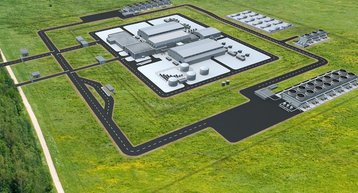Shell has signed with US nuclear pioneer NuScale to assess the idea of putting hydrogen production systems at small nuclear power plants.
The two plan to develop an integrated energy system which would produce hydrogen, using electricity and waste heat from a NuScale Voygr small modular reactor (SMR) plant The hydrogen could be used to store excess energy that can be used to balance the grid.
Small modular reactors (SMRs) have been proposed as a practical way to deliver nuclear power plants without the lengthy delays and overruns associated with large scale nuclear power stations. Both NuScale and Britain's Rolls Royce have suggested that they could be used to deliver clean power to large projects such as data centers.
NuScale has a license for its SMR plants in the US.
Can nuclear and hydrogen mix?
SMRs can be built with prefabricated equipment made in factories, and delivered quickly to multiple sites, with suppliers providing one standard design for approval in multiple locations. They have been proposed as a way to balance clean energy production with energy demand, by using surplus power to generate hydrogen in an electrolysis cell, so it can be stored before being used as a fuel, either through burning or in a fuel cell.
NuScale Power and Shell Global Solutions, along with other industry partners, will develop and assess a concept for an economically optimized Integrated Energy System (IES) that produces hydrogen using electricity and process heat from a NuScale Voygr plant.
The project will have two phases, and be supported by Idaho National Laboratory, Utah Associated Municipal Power Systems (UAMPS), Fuel Cell Energy, FPoliSolutions, and GSE Solutions.
“Hydrogen has been identified as a pathway for global decarbonization and NuScale’s SMR technology complements this goal through low carbon hydrogen production,” said John Hopkins, NuScale Power president and CEO.
NuScale will use a control room simulator to show how the reactor would work with the IES, as well as include models for the Solid Oxide Electrolysis Cell (SOEC) system for hydrogen production, and the RSOFC for electricity production.
NuScale's Voygr reactor is put together from up to 12 multiple 77MW Power Modules. The project will look into how many of these modules would be needed, and the amount of hydrogen storage required. It will also analyze the economics of the idea, based on local market factors.
“We are pleased to join this collaboration, which is in line with our efforts to explore technologies that have the potential to enable decarbonization and support the energy transition,” said Dirk Smit, Vice President of Research Strategy at Shell.
Earlier this year, Shell announced that its Easter Petroleum division is working with Keppel Data Centres in Singapore, to examine the feasibility of microgrid systems that can combine multiple energy sources, including imported renewable power, and hydrogen. Low-carbon energy hubs could be located at infrastructure sites such as cable landings and turbines

